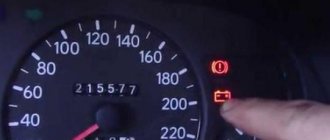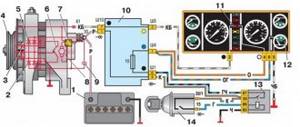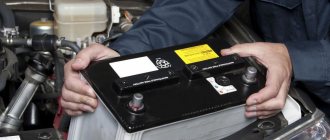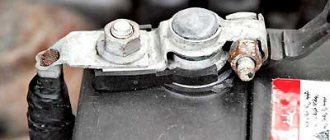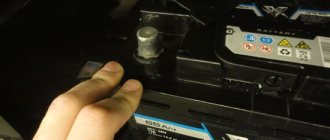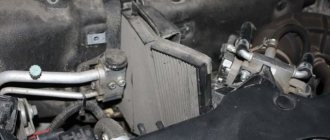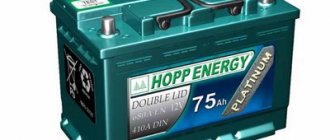There are many reasons to remove a car battery. The battery may be dead or the car may be stored in sub-zero temperatures during the winter without any mileage. Perhaps you are handing over your equipment for repair, selling or replacing the battery. Removing the battery from a car is not difficult, but there are certain rules on how to do this without negative consequences for the equipment. The sequence of actions is prescribed in the vehicle operating instructions. Failure to follow the rules can lead to a short circuit, failure of the electronics, generator, and even electric shock to the “craftsman.”
How to properly remove the battery from a car
When working with a battery, you must remember that despite the harmless voltage, a current of 50-1000 A is generated in the car. When a short circuit is formed, a body with a negative charge becomes deadly. How to safely remove a car battery? First of all, the cathode voltage is removed - the negative wire connector. In this case, a short circuit is eliminated when connecting the positive terminal to the body with any random jumper.
The battery can be located under the hood, in the trunk or under the front seats in the cabin.
- It is necessary to free the battery from thermal insulation and protective covers.
- Make sure the terminals are clean and first remove the ground connection.
- Before removing the terminal from the car battery, you need to swing it, turning it clockwise and counterclockwise. We will do the same with the positive connection.
Now you need to free the body from the clamps and gently remove it. How to remove the battery if the car has an alarm system? This aspect must be taken into account. A completely disconnected power supply may force the ECU to be reprogrammed. It happens that the alarm goes off during the period when the terminals are disconnected, then the sound must be turned off in advance. During the battery disconnection period, the doors may be blocked. That is why the keys to a working lock should be outside the car.
Do you always need to remove the battery from your car to service it? Preventive inspection and measurements are made at the installation site:
- The voltage at the terminals is measured with an open circuit using a multimeter. When the full charge is below 12 V, the battery needs to be charged.
- The battery voltage at the terminals should be 13 - 14.4 V at full load and all consumers connected.
- The control of electrolyte in banks when using serviced devices is checked using a glass tube.
- The density of the electrolyte is determined by a hydrometer 3 hours after charging.
- The electrolyte for central Russia should have a density of 1.27 - 1.29 g/cc. In the northern regions - 1.3 g/cc.
Sometimes it is necessary to remove the battery caps to measure the electrolyte level. Lids or stoppers provide access to the inside of the jar. They can be made flush with the body. You can unscrew the part using a 5 ruble coin or another wide flat object. Before removing the plug, you should wear rubber gloves - there is electrolyte inside. When recharging old batteries from the mains, the caps must be removed.
How to remove the battery from a car
Instructions for dismantling the battery may vary depending on the car model. So, on some machines there is a special panel or toggle switch that turns off the ground. If the car has an alarm system, then removing the battery resets the on-board computer software. Turning off the power can reset the settings of the car radio, automatic transmission and ECU. The doors may also be locked, so the keys must be removed from the car in advance.
On top foreign cars, such as Infiniti, Lexus, it is generally undesirable to remove the battery for a long period of time. Such machines contain several control units, which are powered by built-in additional small batteries. Without a main external energy source, they will fail within 2 months.
All these subtleties must be taken into account before removing the battery. A car battery is usually located under the hood, in the engine compartment. However, it is also found in the trunk or under the front seats in the car.
As for the general rules, there are few of them:
- Before removing the battery, be sure to turn off the engine;
- remove the ignition key;
- turn off all current consumers in the car.
Remove the battery carefully. The work area should be free, not crowded. It is recommended to prepare wrenches in advance for removing terminals and strapping. It is prohibited to tap rusty or tightly fitting fasteners on the battery, as this can lead to the destruction of the fragile internal lead plates.
Here are brief instructions for proper extraction:
- First, remove the battery from thermal insulation and protective covers, check the cleanliness of the terminals;
- disconnect the negative terminal, then the positive one;
- remove the fastening clamps and strapping;
- carefully lift the battery;
- Place on a flat surface, table.
Advice. In order for the terminals to easily come out of the battery terminals, it is recommended to swing them a little, turning them to the right and left.
It is important to be careful! Despite the 12-volt, seemingly harmless voltage, a current of 1000 amperes is generated in the machine. If a short circuit occurs, you can get a dangerous electric shock, because the metal surfaces of the body are connected to the negative side. It is for this reason that when removing a battery, the negative terminal is removed first. This prevents a short circuit if the positive terminal accidentally comes into contact with the body.
The stand on which the battery stood in the car should be cleaned of toxins. Acid can accumulate in this place, so it needs to be neutralized by cleaning with special means.
Is it possible to remove the battery while the car is running?
There are situations when the battery is removed while the car engine is running. Experts say that on old Soviet-made cars, such as Volga and VAZ, you can remove the battery from a running car. In this case, you should set the engine speed to average, connect consumers to average voltage surges. In this case, it is necessary to handle the positive line carefully and ensure its 100% isolation from metal parts and the housing.
Is it possible to remove the old battery from a running car and install a backup battery? When replacing the battery on modern cars with finely tuned electronics, it is necessary to create a jumper between the two power sources. Replacing the battery while the engine is running will allow you to avoid reconfiguring the ECU, since the voltage in the control networks does not disappear. The jumper is removed last, when the new battery is secured at the installation site.
Long-term battery storage using boric acid without refilling
As a last resort, if it is not possible to regularly charge the battery to maximum values in winter, boric acid should be used to reduce self-discharge. In a similar way, you can store a “spare” power source for a car in a garage or apartment for many months. To reduce self-discharge, a 5 percent solution of boric acid is poured into the battery according to the following system:
The battery is charged to the limit with the electrolyte that it contains;- After charging, the electrolyte must be gradually completely drained, but not faster than 15 minutes;
- Next, the battery needs to be rinsed 2 times with distilled water, and during each rinse it is recommended to leave the power source filled with water for 20 minutes;
- The last step is to fill the battery capacity with a 5 percent boric acid solution;
- After following the instructions described above, the battery can be stored for a long time.
Attention: Boric acid is sensitive to changes in temperature, so the battery filled with it must be stored in a relatively warm place at temperatures above 0 degrees Celsius. However, do not forget that the power supply housing should not be exposed to direct sunlight.
A “canned” battery can be stored for more than 15 years at a temperature of 0 degrees Celsius. In warmer conditions, its shelf life becomes shorter. Experts do not recommend storing the battery for more than 9 months without checking at temperatures above 20 degrees Celsius.
To restore the battery to working condition after storing it using boric acid, follow the instructions below:
- Boric acid is slowly drained from the battery - within 15-20 minutes;
- After the boric acid is completely drained, the required volume of electrolyte is poured into the battery, which is a mixture of sulfuric acid and distilled water with a density of 1.83 g/cm3. The electrolyte should be added at a temperature of 15 to 30 degrees Celsius;
After updating the electrolyte in the battery, you need to make sure that its density does not decrease. To do this, it is better to leave the battery for 40 minutes, and then measure the density of the electrolyte. If everything is in order, the battery can be installed in the car and be sure that at the most inopportune moment there will be no need to start the car with a dead battery.
( 445 votes, average: 4.50 out of 5)
Features of operating car batteries in winter and at elevated temperatures
The starter clicks but does not spin: cause, diagnosis, repair
Related Posts
How to lock a car with the battery removed
Before removing the battery, you need to make sure that the central lock is mechanically sound and locks against rotation. Is it possible to remove the battery from the car when the lock is closed? Procedure for a working key:
- opening the car with the key fob;
- battery dismantling;
- closing the door with a key;
- opening the door with a key;
- opening the hood and installing the power source;
- working with a keychain.
Another sequence is also used. They practice loosening the terminals and fasteners on the battery. Within 30 seconds, you need to remove the battery and close the hood so that the emergency lights do not turn on. Then the car is opened using the key fob. Sometimes difficulties arise when the battery is in place, but has run out. Then they use methods to penetrate the salon, using special and improvised means.
How to store a battery in winter?
The main thing to remember regarding the safety of the battery in winter is its position in space. Never store the battery vertically or on its side. The power source, dry charged or filled with electrolyte, must always be horizontal.
To store the battery in winter, you need to choose the right place according to the following criteria:
- The battery housing should not be exposed to direct sunlight. That is why, if there is a choice between storing the battery in the pantry or on the balcony, it is better to give preference to the pantry or any other “dark” room where the rays of the sun do not reach. The danger when sunlight hits the battery during storage is that it can cause deformation of the case, and this will lead to malfunctions of the power source after connecting to the car;
- The temperature where the battery is stored should be above -5 degrees Celsius. You can leave the power source to overwinter in the cellar or basement, where the temperature, if it drops below zero, does not drop by much;
- The room should be well ventilated and not have high humidity. This is due to the fact that during self-discharge the battery releases a mixture of oxygen and hydrogen, which is explosive. During long-term storage, self-discharge is inevitable, and its magnitude depends on the air temperature - the higher, the greater.
Storing a battery with electrolyte requires not only the correct selection of the room, but also its preparation for “wintering”. On many forums they write that you should drain the electrolyte from the battery to better preserve it in winter - this is a lie. Moreover, before storing, it is necessary to check the electrolyte level in the battery. If it turns out to be low, add distilled water to the battery, and then charge it as much as possible.
Attention: Only distilled water can be filled into the battery. Never add tap water or acid as this may cause undesirable reactions that will damage the power source.
